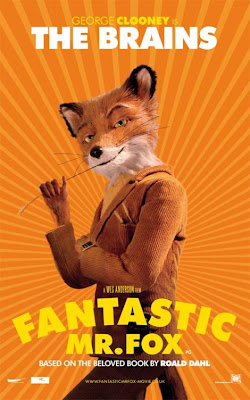Or, read the full story below.
WES ANDERSON VENTURES INTO STOP-MOTION ANIMATION – IT’S CUSSIN’ GOOD by Raen Payne
Wes Anderson’s The Fantastic Mr. Fox, based on a story by Roald Dahl, has been described as a comeback after the critical disasters that were The Darjeeling Limited and The Life Aquatic.
Though most animated films adhere to a particular studio’s look and tone – think Pixar or DreamWorks Animation – Mr. Fox has no such limitations or backing. His stop-motion film captures the look of the book’s illustrations as well as Anderson’s directorial style. A strong effort has been made to portray the stiff two-dimensional quality of a picture book. Shots are often divided into flat planes. During action scenes, such as when Mr. Fox and the other animal characters must dig tunnels to flee their pursuers, the frame is filled with a two dimensional cross section of the world above ground and the many layers of dirt beneath.
Anderson’s live action films are often characterized by dry wit and the deadpan delivery of emotionally charged lines. Mr. Fox is no exception. Anderson approached animation, as he would have any live action film.
During a Charlie Rose interview on PBS Anderson speaks less about the techniques of animation and more about his ignorance, “I didn’t really know that much about the process (directing animation). I just knew I liked the way it looked in movies.” He also said about the making of the film, “This one has actually been great, I really enjoyed this one.”
The play between the possibilities of stop-motion and the experience of directing live action films is what makes Mr. Fox unusual and fresh. The film has, along with Coraline and Mary and Max, reminded audiences this year that stop-motion is just as viable commercially as computer-generated fare and costs a lot less to make. Anderson’s budget was around $40 million.
Though Anderson is primarily a live action director, or perhaps because of it, Mr. Fox was directed as a live action film. The movie is dialogue driven and shot as any other film of Anderson’s might be. With Mr. Fox, Anderson has demonstrated that it’s possible for any live action director to helm a successful animated feature with a small budget. This raises the possibility that other live action directors could produce innovative and stylized animated features. It is possible that a director with an even more pronounced one, such as Quentin Tarantino, could direct in animation.
Though most animated films adhere to a particular studio’s look and tone – think Pixar or DreamWorks Animation – Mr. Fox has no such limitations or backing. His stop-motion film captures the look of the book’s illustrations as well as Anderson’s directorial style. A strong effort has been made to portray the stiff two-dimensional quality of a picture book. Shots are often divided into flat planes. During action scenes, such as when Mr. Fox and the other animal characters must dig tunnels to flee their pursuers, the frame is filled with a two dimensional cross section of the world above ground and the many layers of dirt beneath.
Anderson’s live action films are often characterized by dry wit and the deadpan delivery of emotionally charged lines. Mr. Fox is no exception. Anderson approached animation, as he would have any live action film.
During a Charlie Rose interview on PBS Anderson speaks less about the techniques of animation and more about his ignorance, “I didn’t really know that much about the process (directing animation). I just knew I liked the way it looked in movies.” He also said about the making of the film, “This one has actually been great, I really enjoyed this one.”
The play between the possibilities of stop-motion and the experience of directing live action films is what makes Mr. Fox unusual and fresh. The film has, along with Coraline and Mary and Max, reminded audiences this year that stop-motion is just as viable commercially as computer-generated fare and costs a lot less to make. Anderson’s budget was around $40 million.
Though Anderson is primarily a live action director, or perhaps because of it, Mr. Fox was directed as a live action film. The movie is dialogue driven and shot as any other film of Anderson’s might be. With Mr. Fox, Anderson has demonstrated that it’s possible for any live action director to helm a successful animated feature with a small budget. This raises the possibility that other live action directors could produce innovative and stylized animated features. It is possible that a director with an even more pronounced one, such as Quentin Tarantino, could direct in animation.

No comments:
Post a Comment